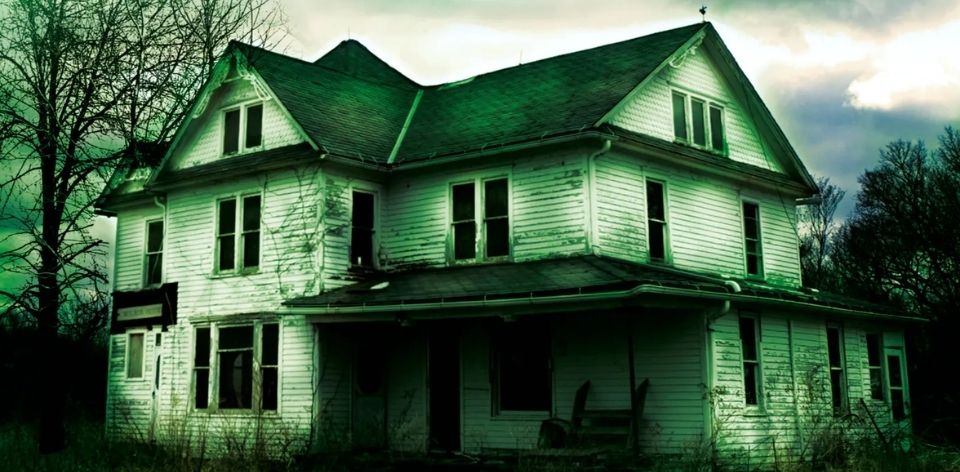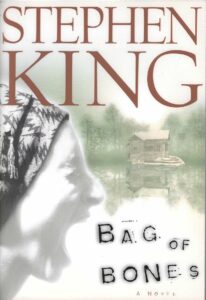Welcome back to Inconstant Reader, the feature column that explores Stephen King’s books in the order they were published — sort of! A ghost story inspired by Rebecca? Ayuh.
WARNING: There’s a bagful of spoilers from here on out.
With Desperation, Stephen King ended his longstanding relationship with publisher Viking, who he had been working with since 1979’s The Dead Zone. So, in 1997 he signed an initial three-book deal with Simon & Schuster, and off the back of a multi-million dollar advance he published BAG OF BONES the following year. It is born of a desire to write “one more good scary story” before turning 50.
Partly inspired by Rebecca, and filled with allusions and references to Daphne du Maurier’s classic, this 1998 novel unsurprisingly focuses on a writer. Mike Noonan is a successful genre writer, but following the sudden death of his wife Jo, he succumbs to severe writer’s block. After fooling his publisher with a stock of old manuscripts, he finally heads to his Maine vacation house on Dark Score Lake, a place known as “Sara Laughs” in the unincorporated town of TR-90.
Yet his fate takes a turn when he meets the 3-year-old Kyra and her 20-year-old mother Mattie Devore. Her father-in-law, tech mogul Max Devore, is trying to wrestle custody of the young girl by any means necessary. Mike finds himself rushing to their defence, using his own means to hire Mattie a lawyer while becoming involved with the family. Yet his persistent bad dreams and visions and personal and physical assaults from Max complicate things. Not to mention the ghost of his dead wife helping him solve the mystery of Sara Tidwell, a blues singer who haunts the house he is staying in.
Initially reported to be around a thousand pages, the final product comes in at a little over half that length. It’s still a complex and often dense novel, clearly a mixture of a writer working through projections of personal grief while balancing the twists and turns of a ghostly mystery. This is the kind of writing King excels at, combining an eclectic group of characters with a rich and vivid depiction of idiosyncratic Maine as only King knows it. As he says in the Q&A in the backmatter, possibly paraphrasing Edwin Arlington Robinson, “a place is yours when you know where all the roads go.”
There are a few problematic aspects to the book though. Mattie is largely objectified as a character: she’s the object of affection for both Mike and her own lawyer, and a target for removal by Max. Through fantasy sequences and some later implications, King normalises an age-gap in a relationship that would typically belong in a Woody Allen film. Yet King also spends a passage discussing the “strange midlife realities of my generation: we can’t touch a child who isn’t our own without fearing others will see something lecherous in our touching…or without thinking, way down deep in the sewers of our psyches, that there probably is something lecherous in it.” Suffice it to say, the tone is occasionally baffling.
“Ghosts can’t hurt anyone. That’s what I thought then.”
There’s also the matter of King once again using race and identity as a shorthand to progress the narrative. In this case, it’s historic racial violence in Maine (where almost 95% of the population identifies as White, and less than 2% of the population is Black). It’s dealt with here as the curse of Sara Tidwell, who has killed every descendant of the town residents who did her wrong (and whose names all start with ‘K’ for some reason). It’s a step forward from magic characters like Mother Abigail, Dick Hallorann and John Coffey, but it is still another example of King investing a person of colour with mystical powers beyond the grave. It’s an echo of Pet Sematary in that sense, as New England’s inherited colonial crimes travel down through the generations. Hell, there’s even a few coy references to the Micmac tribe here.
This is all the base stuff of throwback horror stories, and King genuinely scares various amounts of bejesus out of readers at regular intervals. Starting out with fridge magnets that spell words of their own accord, it culminates in a back-heavy maelstrom of past and present tragedies coalescing in a classic haunted house narrative. That said, sometimes it’s the human element that frightens more. There’s a scene in which Max Devore and his right hand woman attack and nearly drown Mike, and it’s tense as any scene King has written over the years.
For Constant Readers, there are a plethora of references to The Dark Tower and the King multiverse more broadly. A thoroughly Maine story, from ayuh to zyuh, there’s passing references to Bill Denbrough (of It) and Thaddeus Beaumont (The Dark Half). The house, Sara Laughs, is the Twinner of Cara Laughs, a house the fictionalised King moved into on Turtleback Lane in the Keystone World. There’s an argument that Mike is King’s Twinner, which does make the relationship with the significantly younger Mattie all the more pointed.

This also goes some way to explaining why the air around several locations is ‘thin’ — typically an indicator of Todash space — allowing for the appearance of various entities. Indeed, at least one is referred to as ‘the Outsider,’ a term that continues to be used to describe Todash creatures in modern King literature. The number 19 turns up in multiple instances, from crossword clues to other less subtle instances. Our old cop pal Norris Ridgewick turns up in the denouement.
Of course, BAG OF BONES isn’t just one of King’s most literary novels because of the intertextuality with his own work. With references to Bleak House and Herman Melville’s Bartleby, and a backbone made of solid Rebecca, it’s one of the cleanest examples of King’s keen (and often encyclopaedic ) knowledge of literary horror history. It is, in the author’s words, a “haunted love story” that speaks to his constant passions for writing and his wife Tabitha. It’s a theme that carried through to the later Lisey’s Story. After all, as Mike Noonan comes to realise, “Marriage is a zone too, you know. Marriage is a zone.”
In the last one of these for 2021, Inconstant Reader explores King’s love of baseball in The Girl Who Loved Tom Gordon. While you’re here, go check out Batrock.net, where my buddy Alex Doenau is running through this Stephen King adventure with me.





